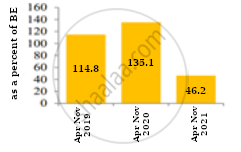Advertisements
Advertisements
प्रश्न
How good is the system of G.S.T as compared to the old tax system?
उत्तर
The system of G.S.T is good as compared to the old tax system in the following ways:
- Abolition of different tax structures - The implementation of GST resulted in the abolition of state-imposed taxes such as value-added tax, entry tax, octroi, and luxury tax as well as service tax, union excise duty, central sales tax (collected by states), and customs duty. Cess, resale, extra, and turnover taxes, among others, have all been abolished.
- Widening of tax bases - The GST has broadened governments' tax bases. Government administrative expenses have decreased as a result.
- The benefit of Input tax credit - Every stage, whether for the manufacturer, middleman or end user, is subject to the GST levy. The assessee benefits from an input tax credit side by side, which means he simply has to pay the difference between output tax and input tax. As a result, GST has eliminated the tax's cascading effect, following in the footsteps of VAT.
- Neutralization to process, business models, structure, and location - Because of the neutrality of the tax regime, GST is expected to improve economic development, efficiency, and sustainability.
- Because of the lessened effect of tariffs on numerous commodities, GST may contribute to an increase in exports, giving exporters an advantage over their competition in the worldwide market.
- Increased demand and production of goods and services - Because of the GST's lower production costs, manufacturing facilities would grow and there would be more demand for goods and services.
APPEARS IN
संबंधित प्रश्न
Distinguish between revenue deficit and fiscal deficit.
Define fiscal deficit
Define revenue
‘The fiscal deficit gives the borrowing requirement of the government’. Elucidate.
Give the relationship between the revenue deficit and the fiscal deficit.
Suppose that for a particular economy, investment is equal to 200, government purchases are 150, net taxes (that is lump-sum taxes minus transfers) is 100 and consumption is given by C = 100 + 0.75Y (a) What is the level of equilibrium income? (b) Calculate the value of the government expenditure multiplier and the tax multiplier. (c) If government expenditure increases by 200, find the change in equilibrium income.
Consider an economy described by the following functions:- C = 20 + 0.80Y, I = 30, G = 50, TR = 100, calculate the effect on output of a 10 per cent increase in transfers, and a 10 per cent increase in lump-sum taxes. Compare the effects of the two.
Explain why the tax multiplier is smaller in absolute value than the government expenditure multiplier.
Does public debt impose a burden? Explain.
Discuss the issue of deficit reduction.
What do you understand by G.S.T?
Suppose you are a member of the "Advisory Committee to the Finance Minister of India". The Finance Minister is concerned about the rising Revenue Deficit in the budget.
Suggest anyone measure to control the rising Revenue Deficit of the government.
The primary deficit in a government budget is ______.
Read the following statements carefully and choose the correct alternatives given below:
Statement 1: Fiscal Deficit = Total Budget Expenditure - Total Budget Receipts (Net of borrowing)
Statement 2: Primary Deficit = Fiscal Deficit + Interest Payments.
When the revenue receipts are less than the revenue expenditures in a government budget, this shortfall is termed as
The difference between fiscal deficit and interest payment is known as ______
What is relation between government deficit and government debt?
If India exports goods worth ₹20 crores and imports goods worth ₹30 crores, it will have a ______
Fiscal deficit equals:
Compare the trends depicted in the figures given below:
| Figure 1: Trends in Fiscal deficit and Primary deficit |
Figure 2: Fiscal deficit as a percent of Budget estimate |
 |
 |
